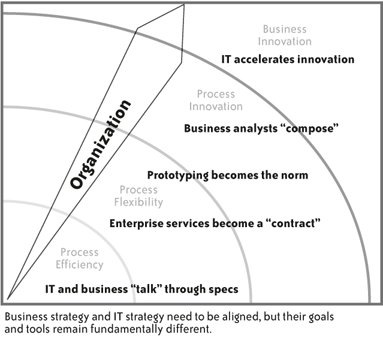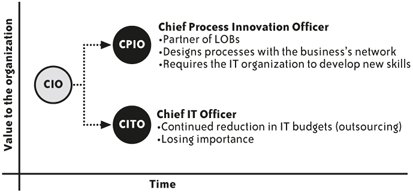Section 3.8. What do you mean by
3.8. What do you mean by "business process?"By business process, we mean the progression of steps necessary to complete a given task in the pursuit of making more money. These aren't necessarily the steps written down in some manual or encoded in your Enterprise Resources Planning (ERP) installation. These are the steps involved in "how business works," the ballet of data creation, manipulation, and distribution across the enterprise. An inherent flaw in the current generation of enterprise software is that it assumed that the reigning business processes at the time of their creation could be hardcoded for eternity in a monolithic application designed to be the Platonic ideal of how a set of processes should be performed. "Best of breed" applications were designed to be the last word in their given fields, even though they weren't; they did a great job handling stable tasks, but due to the ever-accelerating pace of competition, business conditions began changing so quickly that processes no longer supported new requirements for processes that crossed application boundaries. Likewise, the underlying software failed to keep up with the dynamic, on-the-fly business processes emerging to meet these challenges, leading to a point where IT and business processes forked. The functionality is now trapped in increasingly obsolete applications while the users have moved on, unconsciously creating ad hoc process steps and relationships to plug the cracks in the monoliths. As discussed in Chapter 2, ESA's strongest argument in the business case is its unprecedented ability to free that trapped functionality and abstract it to a new service-enabled platform that's flexible enough to keep pace with change. Before IT can make that happen, the business side must develop the ability and requisite skill set to think about business logic explicitly in terms of process models and services. The IT side must be willing and able to listen and to play a new role as process innovator. Figure 3-4 summarizes the new organizational relationship. Enterprise services are a key element to this transition because they represent complete units of functionality designed to automate a business process. Executives and managers must develop the ability to visualize, using enterprise services, the previously occluded steps that bind business logic together. To automate something as simple as "order to cash" might mean you must isolate and highlight a dozen steps that draw upon a half dozen enterprise applications. In a fully realized Enterprise Services Architecture, the business analyst and IT will sit down together and use enterprise services as a common language to map business processes as they currently are, and chart a course for how they could and should be recombined and composed at lower cost and with greater efficiency, and then implemented by IT. The traditional role of the CIO is imagined as being split in two in order to better reflect the role of the business side in IT decision making. As shown in Figure 3-5, the chief process innovation officer (CPIO) evolves to become the C-level link between the two cultures. (We discuss the CPIO in detail later in this chapter.) As we noted earlier, in our first book, Enterprise Services Architecture (O'Reilly), we referred to the first step toward ESA adoptioni.e., conceptionas The Big Think. During The Big Think, a steering committee composed of business executives and IT architects sits down Figure 3-4. Culture change: from org chart to processes and opportunities Figure 3-5. The new role of the CIO to trace a map of the company's IT universe as it exists. What are the most important business processes? How many of those processes do existing applications automate? Of those applications, which ones contain data objects and services that might be useful elsewhere? ...and so on, drilling down into the enterprise. Until both parties are able to sit at the same table, speak the same language, and identify the business logic embodied in those processes, however, you're not even ready to take the first step. Figure 3-6 summarizes the path to readiness. |
EAN: 2147483647
Pages: 265